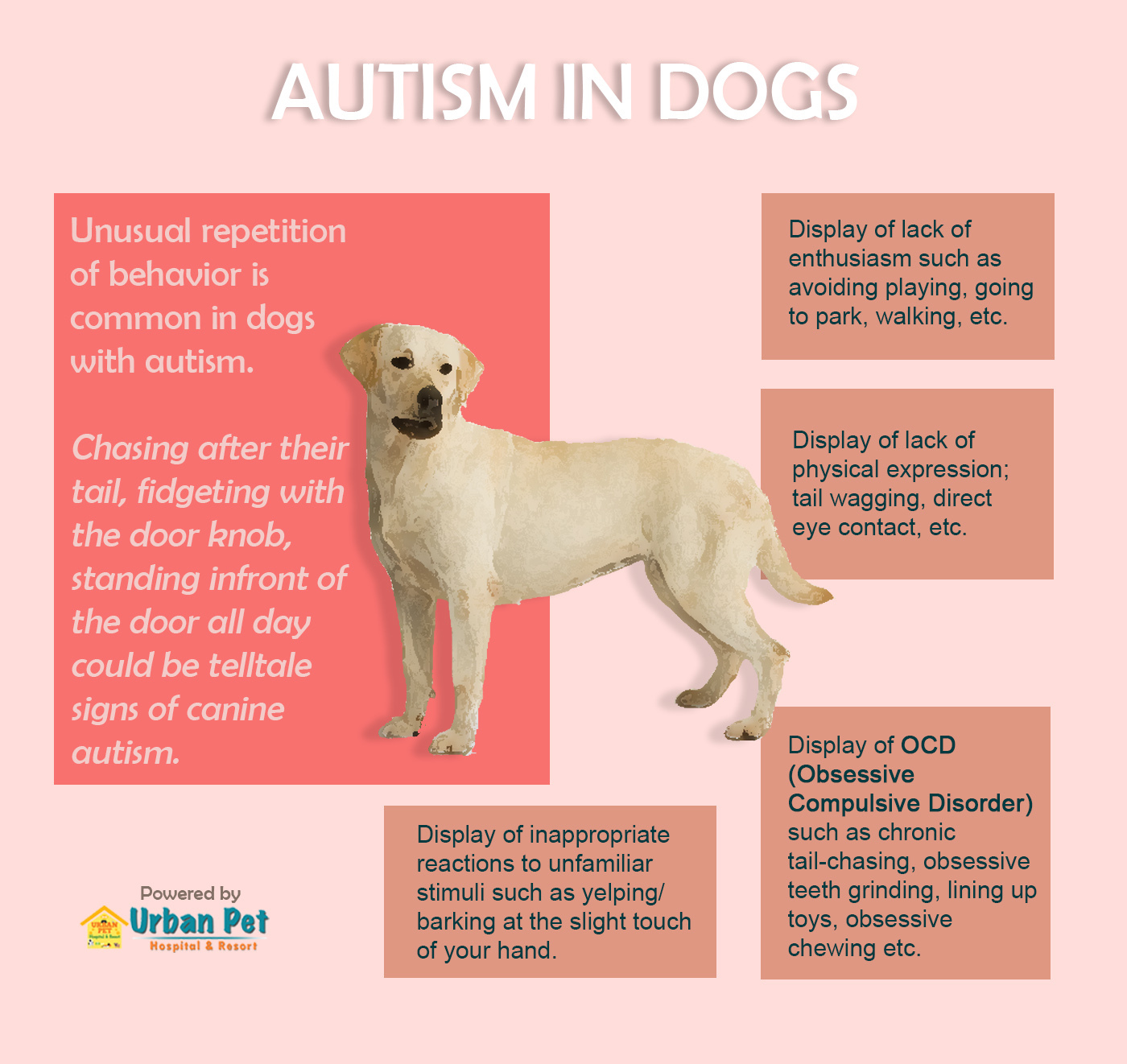
Autism or canine autism refers to a broad range of conditions characterized by difficulties with social skills and repetitive behaviors, including aggression and withdrawn behavior.
People often associate autism with humans, and many believe that this condition does not affect dogs, but this isn't true. When you use the same autism spectrum disorder typically applied to human behavior, it becomes apparent that dogs can be diagnosed with autism.
Yes, dogs can be autistic, according to many types of research. The signs and suffering from autism may differ from one dog to another. Canine autism can affect their social skill and behavior. They can show episodes of sudden aggression, withdrawn behavior, and a lack of activity.
Canine Autism
Autism spectrum disorder in dogs is an idiopathic condition, which means that the cause is unknown. However, we know that it’s congenital and that dogs exhibiting dysfunctional behaviors are born with the condition.
Although the scientific community often attests that canines can't suffer from autism, many dog behaviorists and animal experts have pointed out that dogs have been diagnosed with autism-like symptoms.
The veterinarians first observed autism-like symptoms in dogs back in the 1960s. Since then, they have carried out different research types to learn more about autism-like symptoms in dogs.
The American College of Veterinary Behaviorists (ACVB) presented a study on tail-chasing behavior in Bull Terriers and a possible link to autism in 2015. It observed specific traits of 132 Bull Terriers, 55 of which chased their tails, and 77 (the non-tail-chasing control group). It found out that tail-chasing was more prevalent in males Terriers, and it was associated with occasional aggression and explosive behaviors, including trance-like behaviors.
Although not definitive, these results suggested that tail-chasing could represent a form of autism in dogs.
Diagnosis of Autism in Dogs

Diagnosing the autism spectrum disorder in dogs is rather difficult because there are only tell-tale signs of autism that aren't backed by scientific evidence. The signs of autism shouldn't be confused with other medical issues such as canine anxiety or injury-pains. To determine if your dog is suffering from either autism or other illness, you should consider taking it to the vet for a thorough diagnosis.
Vets can perform several behavioral tests to assess how a dog responds to certain situations. Still, these tests are not always concrete since other disorders such as canine anxiety can produce autism-like symptoms. They will rely on tell-tale signs or cues to determine canine autism.
Here are five tell-tale signs of autism.
Display of Repetitive Behavior
Repeating certain patterns and behaviors is one of the tell-tale signs of autism in both humans and dogs. If your canine starts showing unusual repetitive behavior, it's best to ask your vet for a quick diagnosis. It isn't unusual for dogs to chase after their tail, fidget with the door lock, or stand in front of the door every day, and you shouldn't confuse every repetitive behavior with the symptoms of autism. The onset of autistic behaviors is often accompanied by other signs such as withdrawal or sudden aggression.
Display of Social Nervousness and Awkwardness
Dogs are sociable creatures, and they love spending time with humans and other animals. This is one of the reasons why they enjoy visiting the park. Most dogs will seek comfort and safety from their owners.
It's a telltale sign of autism when your dog isn't sociable. Injuries, traumatic history, accidents, and other major events could make many dogs stop interacting or start showing social nervousness, and these shouldn't be confused with autism's symptoms. It's best to observe your dog for any such unusual awkwardness. If your dog is showing similar signs even after a few weeks, it's best to take it to the vet for a diagnosis.
Display of lack of enthusiasm
It's unusual for dogs to display a lack of enthusiasm when you invite them to go out for a walk, take a break in the park, or play any games. While most of the time, the lack of energy and physical lethargy could make them display a lack of enthusiasm, but if this behavior persists for a long time, you should know that there's something wrong with it.
This is often accompanied by a lack of physical expression, including tail wagging, not making direct eye-contact, entering a trance-like state, staring in one direction for a long time, etc.
Display of OCD
Repetitive motions are also a characteristic of autistic behavior. They can include various actions such as circling a room over and over again or chronic tail-chasing or obsessive teeth grinding. Other repetitive behaviors include lining up toys or other objects, placing food bowl in a certain direction, or obsessive chewing.
You'd know the signs of OCD by observing their unusual repetitive behavior. Like humans, dogs can fall victim to OCD because of canine autism.
Display of Emotionless
Dogs may show inappropriate reactions to unfamiliar stimuli such as yelping or barking at the slightest touch of your hand and barking to sudden sounds. Autistic dogs can become hypersensitive to any stimuli.
They often avoid new environments, situations, and social interactions because they may find it difficult to cope with new experiences.
To better diagnose the symptoms of autism, it's best to talk with your veterinarian, who will advise you to observe certain behaviors.
Newly adopted and rescued dogs may become antisocial or show signs of communication issues, lethargy, and reduced physical activity. To learn more about your new pet's behavior, you should talk with the previous owner or the rescue home for more information.
How to Treat Autism in dogs?
After a licensed veterinarian has ruled out other possibilities for your furry friends’ unusual social awkwardness and withdrawn behaviors, you should start seeking possible treatments.
There is no single treatment for autism; hence you should start prescribed medications and advised lifestyle changes.
Medication
Your veterinarian will prescribe medication like Fluoxetine (Prozac) to treat OCD and autism problems in humans.
Offer a Safe, Secured and Stress-Free Place
Your dog may become anxious or nervous in crowds or around other animals. Dogs inhibiting the signs of autism may seek a safe and secure place to spend most of their time. As the certain sound and environment may trigger OCD and bark in autistic dogs, it’s best to provide them a completely stress-free place. Avoiding situations that can stress your dog and cause anxiety is important too.
Offer Regular Exercise and Well-Balanced Diet
Make sure your dog gets enough exercise every day along with a well-balanced diet. Regular exercises and healthy meals can help to reduce anxiety and stress in dogs while keeping them engaged.
Your veterinarian may also suggest you work with professional trainers or therapists who specialize in positive reinforcement. They can help provide therapies and training to curb autistic behaviors in dogs.
Dr. ValliParthasarathy DVM explains that,
Dogs who have anxiety disorders may exhibit symptoms that their owners interpret as autism and diagnose themselves. But in reality, anxiety, in general, can affect a dog’s ability to learn, problem-solve, retain and recall information.
She advises that it’s better to begin working with a positive reinforcement reward-based trainer to help treat your dog’s autistic conditions. It would be best if you also were gentle with your dog at all times.
Check this infographic out for more information in detail.

Get in touch with Urban Pet Hospital & Resort, the best doggy pet hospital in Des Moines, to learn more about diagnosing and treating canine autism.